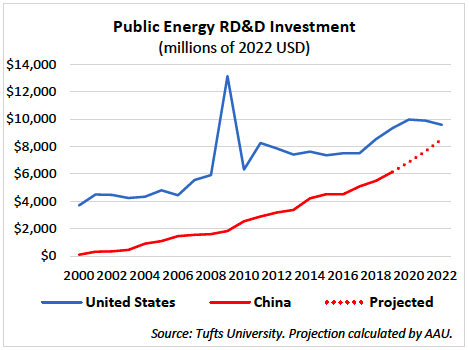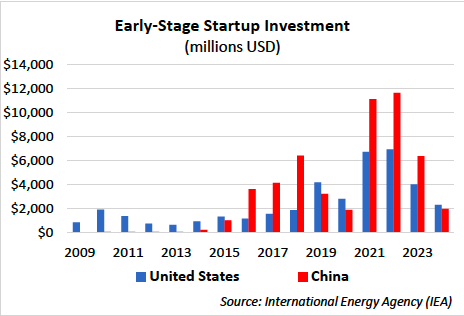The Global Race for Energy Innovation

 Advanced energy technology represents a vast and growing opportunity, with the size of the global clean energy market expected to triple in the coming years. But China, our closest competitor, has ramped up investment in public research, development and demonstration (RD&D) and early-stage startups.
Advanced energy technology represents a vast and growing opportunity, with the size of the global clean energy market expected to triple in the coming years. But China, our closest competitor, has ramped up investment in public research, development and demonstration (RD&D) and early-stage startups.
China’s public investment in energy research, development and demonstration has averaged 12% in annual increases since 2009. As a result, China has pulled near the United States (see top graph). Chinese early-stage startup investment now regularly surpasses U.S. investment following its dramatic recent expansion (see bottom graph).
America can win the race for energy technology leadership, but doing so will require robust support for Department of Energy research through ARPA-E.
ARPA-E is an Effective, Dynamic Model for Energy R&D
- The ARPA model is a time-tested one, based on the high-impact defense agency – DARPA – that helped create the Internet, GPS,stealth, and other revolutionary technologies. ARPA-E adapts this model to the energy sector.
-ARPA-E features a broad portfolio of high-risk, high-reward research with rigorous program design and agile, active management practices. It also focuses on results and market transitions, ensuring promising projects are not
-ARPA-E also emphasizes the creation and nurture of active communities of technology
Market-Driving Results
- Since its inception, ARPA-E has provided $4.21 billion in funding to more than 1,700 projects at universities, small businesses, and national labs in nearly every state.
- ARPA-E projects have drawn nearly $15 billion in private follow-on capital investment over the years – more than tripling ARPA-E’s all-time project investment with public resources.
- ARPA-E project teams have resulted in 167 companies, 1,225 patents, and 452 technology They have also yielded 34 exits through mergers, acquisitions and IPOs worth over $22.2 billion in total.
- ARPA-E also drives science: Researchers supported by ARPA-E have produced over 8,000 peer-reviewed articles in scientific journals.
Securing Abundance, Winning the Tech Race
ARPA-E has helped scientists and engineers turn novel ideas into projects at scale, including:
Fervo Energy, an advanced geothermal company first incubated with support from Stanford University and Berkeley National Lab and funded by ARPA-E in 2021. Fervo’s flagship facility will come online next year; it recently announced a power purchase agreement with Shell Energy.
Sila Nanotechnologies, an advanced battery materials company co-founded by a Georgia Tech professor and supported by ARPA-E in 2018. Sila raised $375 million in its latest funding round and expects its battery facility to commence production in 2025 in partnership with Mercedes-Benz.
Phononic Devices, a thermoelectric startup founded by a USC-trained electrochemist at NASA’s Jet Propulsion Lab, developed first-of-a-kind cooling devices with ARPA-E support in 2009. Continuing to draw follow-on investment, the company now has global partnerships with data centers, logistics companies, real estate developers, and automotive manufacturers.
Antora Energy, an advanced thermal energy storage company founded by Stanford and MIT graduates and first supported by ARPA-E through the DAYS program in 2018. Following research collaboration with the DOE national labs and Arizona State, the company achieved significant thermal technology breakthroughs, began battery production in 2023, and has formed partnerships with Con Edison and Shell.
Solid Power, a solid-state EV battery and charging infrastructure manufacturer funded through the RANGE program in 2013. The company is a licensed spin-out from the University of Colorado-Boulder based on federally funded research. The company received subsequent investment from Ford and BMW before going public in 2021.
Niron Magnetics, an advanced magnet manufacturer, spun out of research conducted at the University of Minnesota and funded by ARPA-E in 2012. The company plans to produce permanent magnets without the use of rare earths, and broke ground on its first production facility in fall 2025.
